Meta MMM Summit 2024: Mastering Cross-Channel Measurement
Meta Marketing Mix Modeling (MMM) Summit "Master Cross Channel Measurement was held in London on the 26th of June 2024. This exclusive event gathered marketing measurement expert’s across the world together with top advertisers to foster innovation and elevate awareness about MMM among Meta's small and medium business community.
Sellforte was invited as an expert role to the panel section of the event and we’ve summed up the event highlights in this blog post.
Welcoming words
We were warmly welcomed by Lizzy Lillington-Lester, Marketing Science Partner at Meta. Lizzy set the stage by highlighting that there are numerous challenges present in today’s advertising ecosystem, particularly regarding cross-channel measurement. These challenges stem from the complexity of tracking and attributing performance across multiple channels, each with its own metrics and data points. These are the reasons why Meta hosted such an event that focused on MMM.
Agenda for the two hour event:
- Welcome by Lizzy Lillington-Lester
- Summit kick-off with Georges Mao
- Introduction to Marketing Mix Modeling (MMM) with Elsa Ögren
- Partner panel: MMM innovation with Meta host Alfonso Calatrava joined by Juha Nuutinen from Sellforte, Joan Miro from Kraz, Michael Kaminsky from Recast and Sam Carter from Fospha.
- MMM success stories with Meta host Alfonso Calatrava and guests from Gina Tricot and Cassandra, Hanna Joelsson, Marcus Österdahl and Gabriele Franco and from DNA ERA and Forvio, Ewa Golinska and Andy Kozak
- Open Source MMM, Project Robyn, with Igor Skokan
- Final thoughts with Lizzy Lillington-Lester
Opening Remarks
The summit was kicked off by Georges Mao, the Meta Director of Marketing Science EMEA, who emphasized the importance of MMM in today's dynamic marketing landscape. Georges noted that measurement is becoming increasingly complex, highlighting that there is no one-size-fits-all approach. Instead, it’s about combining various measurement techniques effectively. He underscored Meta's mission to drive industry practices through data-driven analytical methods.
Georges discussed the significant evolution in privacy policies over recent years, including both private regulations and large-scale policy changes. He pointed out the ongoing transition to a cookieless world which will only highlight the importance of user privacy in the future. Therefore, it will become increasingly difficult to measure marketing efforts with third party data.
Moreover, consumers are evolving and consuming more channels than ever before. For marketers, understanding how these channels complement each other and affect demand incrementally is paramount. MMM has been developed over the past 40 years, and the massive transformation in technology has enabled a paradigm shift in machine learning and predictive analytics. These advancements, combined with more automation, provide more granular data for advertisers, making this the perfect opportunity for MMM. Today, MMM is a faster than ever.
Ultimately, MMM is becoming a fundamental pillar of marketing measurement, offering a forward-looking vision for the future. As Georges highlighted, the modeling provided by MMM is crucial in achieving a comprehensive understanding of marketing effectiveness in the future, paving the way for more strategic and data-driven decision-making.
Introduction to Marketing Mix Modeling
Elsa Ögren, Global Marketing Science Consultant at Meta, provided an insightful introduction to MMM. She emphasized that MMM is not a standalone solution but rather a tool designed to complement other marketing measurement tools. MMM fills the gap left by attribution and experiments by covering opt-out users and cross-publishers. Although MMM is not new, it is being rediscovered for its privacy-friendly and signal-resilient nature. Unlike other methods, MMM does not need user data; instead, it runs on aggregated data, such as campaign-level data.
Due to the current industry challenges, there is an increasing need for MMM to remain relevant. We are witnessing a shift from traditional, classic MMM to a modernized approach. Nowadays, MMM is faster, more transparent, accessible, and validated with ground truth.
Elsa compared MMM to un-baking a cake, which we thought was a great way to explain it. Essentially a cake comes down to the ingredients you use and based on them you can alter the taste of the cake, making it more to your liking. Therefore, by trying to understand the factors that impact KPIs over time, you can adjust your marketing strategy accordingly. MMM works by using historical data and applying regression modeling to analyze the impact of various factors on marketing performance. Hence, it can help you understand what impacts your KPIs and in which way.
Almost any business can benefit from MMM. However, there are some general requirements for its effective implementation:
- Data Availability: Historical data is essential for MMM to function properly.
- Stability and Predictability: Consistent levels of sales data are required, meaning MMM is not ideal for startups.
- Variations in Media Mix: There should be variations in the media mix and varying spend levels to provide the necessary data for analysis.
Here is a comparison of the potential model set ups available on the market:
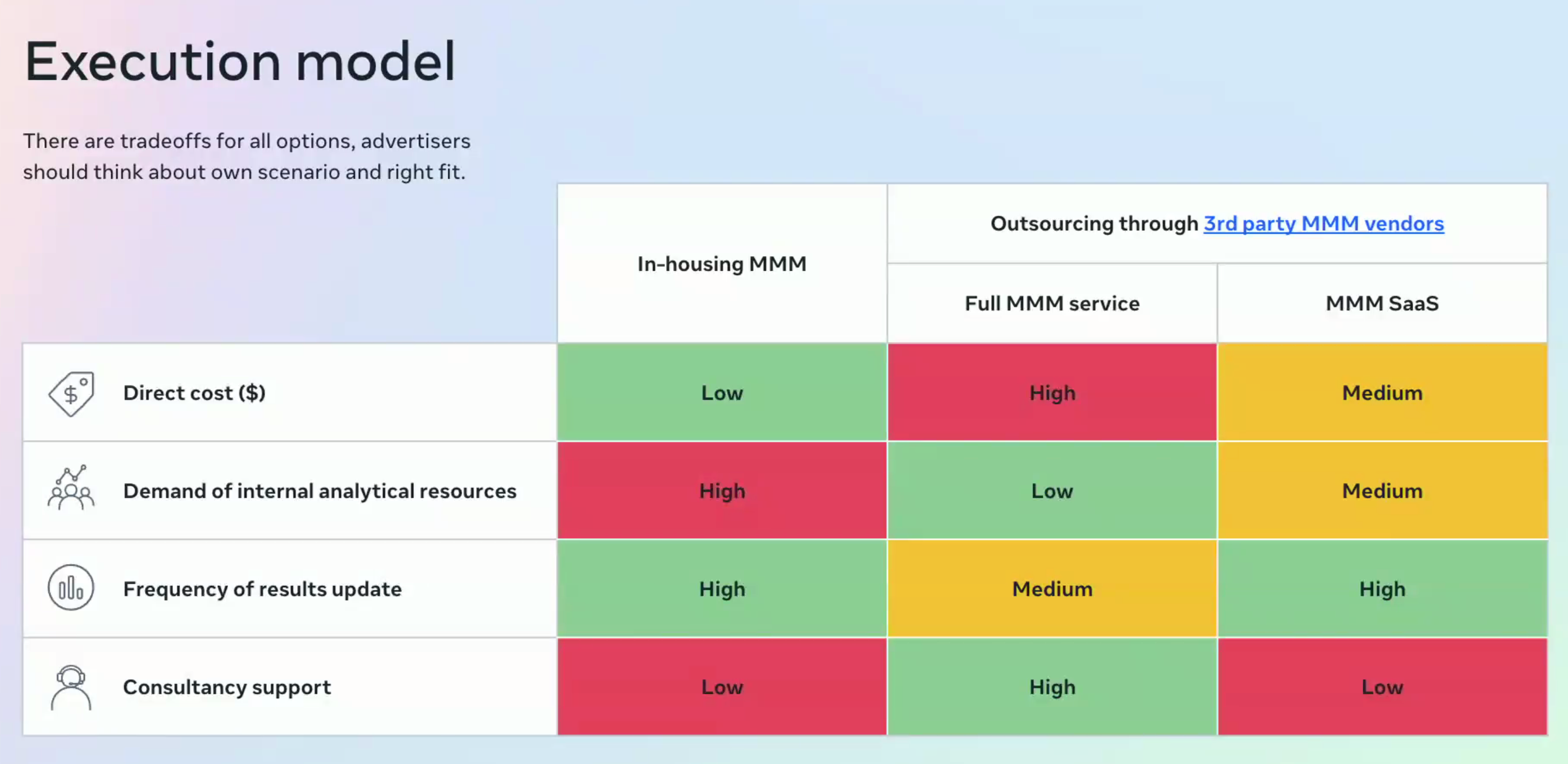
Elsa ended her speech by highlighting the ongoing support that Meta offers for businesses looking to adopt MMM. Meta provides resources and guidance to help companies effectively integrate MMM into their marketing strategies.
Partner panel
The partner panel on MMM innovation was hosted by Alfonso Calatrava, EMEA Third Party Measurement Specialist at Meta, who specializes in cross-media measurements, particularly MMM. His role involves working with Meta's measurement partners and featured external speakers from leading MMM providers.
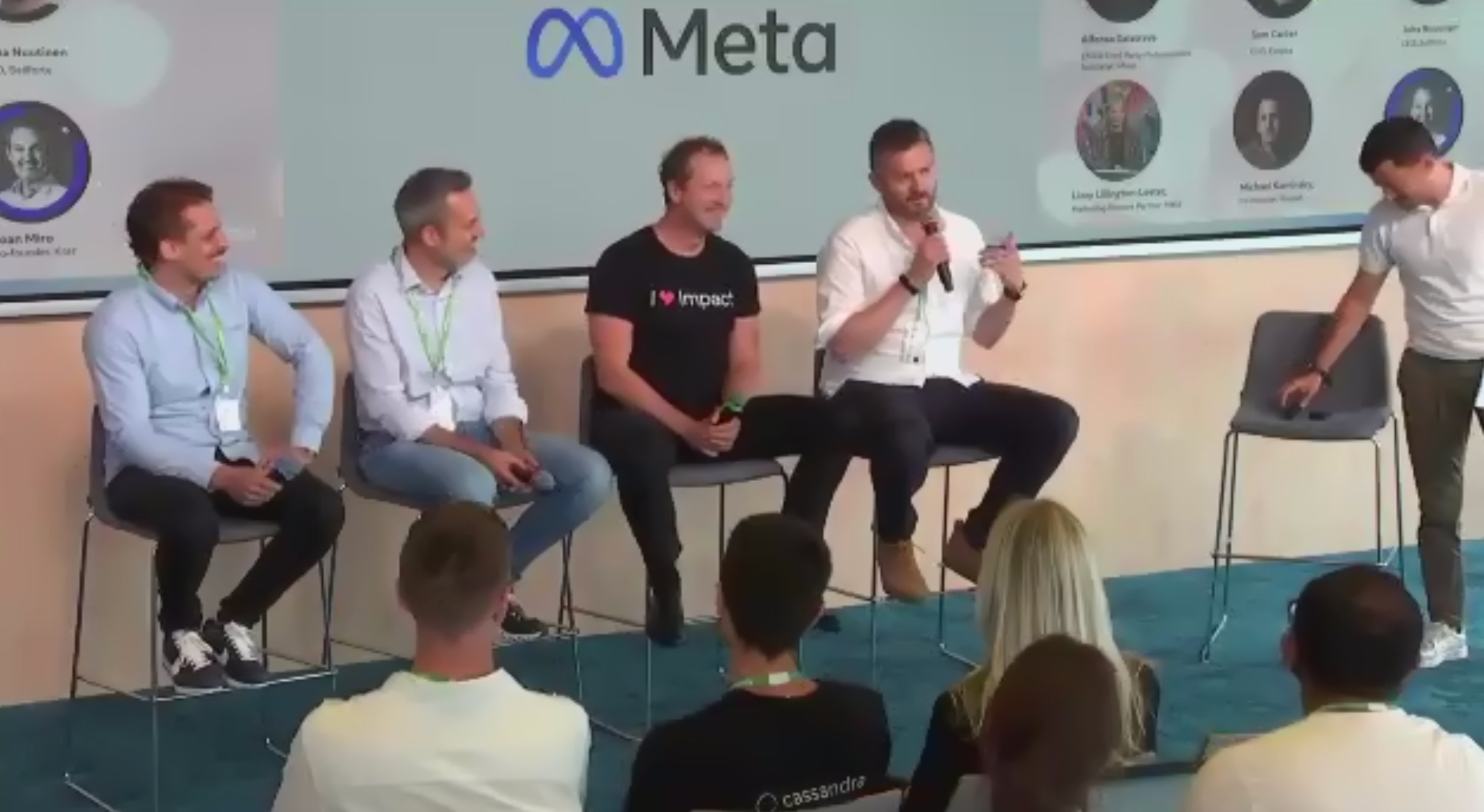
MMM innovation with Meta host Alfonso Calatrava joined by Juha Nuutinen from Sellforte, Joan Miro from Kraz, Michael Kaminsky from Recast and Sam Carter from Fospha.
First, we received a great pitch from all of the panelists on their value:
- Sam Carter from Fospha highlighted that MMM can fill the gap left by attribution. He pointed out that pixel-based measurement is broken and emphasized that Fospha measures all clicks and impressions.
- Juha Nuutinen from Sellforte described Sellforte as an intelligent MMM SaaS service. He stressed that the results are only as good as the data and priors that go into the model. Sellforte integrates all available client data, including ad platforms and Google Analytics. He emphasized that Sellforte is a technology service, not a consultancy, with customer success managers and data scientists ensuring the model is configured correctly. Juha passionately stated, "We love impact. I feel physically sick if customers do not have excellent MMM results! Sellforte stands for quality."
- Joan Mira from Kraz explained that consultancy is a key aspect of their service. While they have a SaaS platform, the consultancy aspect is central.
- Michael Kaminsky from Recast places a lot of emphasis on speed, actionability, transparency, and making the model understandable (a "glass box" instead of a "black box"). They focus on the validation and validity of the model results.
Key Topics Discussed by Alfonso and partners
1. Context of the Industry: Main Challenges in Cross-Media Measurements
- Fospha: The main challenge is pixel-based attribution and the belief that attribution alone is a good way to measure marketing. For those moving beyond attribution, the new challenge is deploying additional measurement techniques.
- Sellforte: There is no single source of truth for marketing incrementality, which is a problem we aim to help customers solve.
- Kraz: The focus is often on the bottom of the funnel, but having answers for every stage of the funnel is the main challenge that Kraz helps solve.
- Recast: Understanding incrementality is not widespread in the industry, and a lot of education is needed to help people understand uncertainty and its implications.
2. AI and MMM Automation
- Recast: AI's implication on MMM mainly involves estimating models, with less need for AI unless looking at machine learning.
- Kraz: The human factor remains important in MMM; there is still a need to choose variables and curate models.
- Sellforte: The primary challenge is data integration. If data integration was automated and very easy then everyone would use MMM immediately.
- Fospha: It is relatively easy to integrate data with digital channels, however, data collection still remains a challenge outside of the digital channels.
3. Implementing MMM as a small business
- Recast: It is difficult for small businesses to do MMM successfully. They should consider MMM only after exhausting other measurement possibilities like experimentation and be willing to invest time and money.
- Fospha: For small businesses, less complexity often means MMM is simpler. A simple channel mix means complexity self-regulates, and MMM can scale from a once-a-year project to addressing specific channel questions.
- Sellforte: Automating data integration and processing, as well as model validation, is crucial. Sellforte has heavily invested in automation, making it possible to integrate data and automate the model in about 15 minutes. Customers still need consultation, but the process is fast and largely automated.
- Kraz: Collecting data takes time, and starting an MMM project requires the same effort for small and large businesses alike.
4. MMM and Trust: How can marketers trust MMM results?
- Recast: Before taking action, you need to build trust by corroborating MMM results with other experiments such as lift tests. If the results align, it usually builds a lot of trust.
- Kraz: Setting up the right expectations is crucial. You must explain what MMM will and will not answer.
- Sellforte: Customers must make changes based on MMM results to achieve impact. They need to understand why the recommendations from the tool are what they are and find supporting evidence from other tools.
- Fospha: Understand the jobs that marketers need to do so that MMM aligns with these goals.
MMM success stories
Gina Tricot & Cassandra
First case study presented was with Gina Tricot, a Swedish fashion chain known for its exciting, feminine, stylish, and affordable fashion, offers the latest trends in over 30 countries, both online and in stores. They partnered with Cassandra for their MMM implementation.
- Challenge: Gina Tricot initially used last-click attribution to measure marketing impact, but with a significant portion of their customers using iPhones, tracking became increasingly difficult. This led them to explore cookieless solutions.
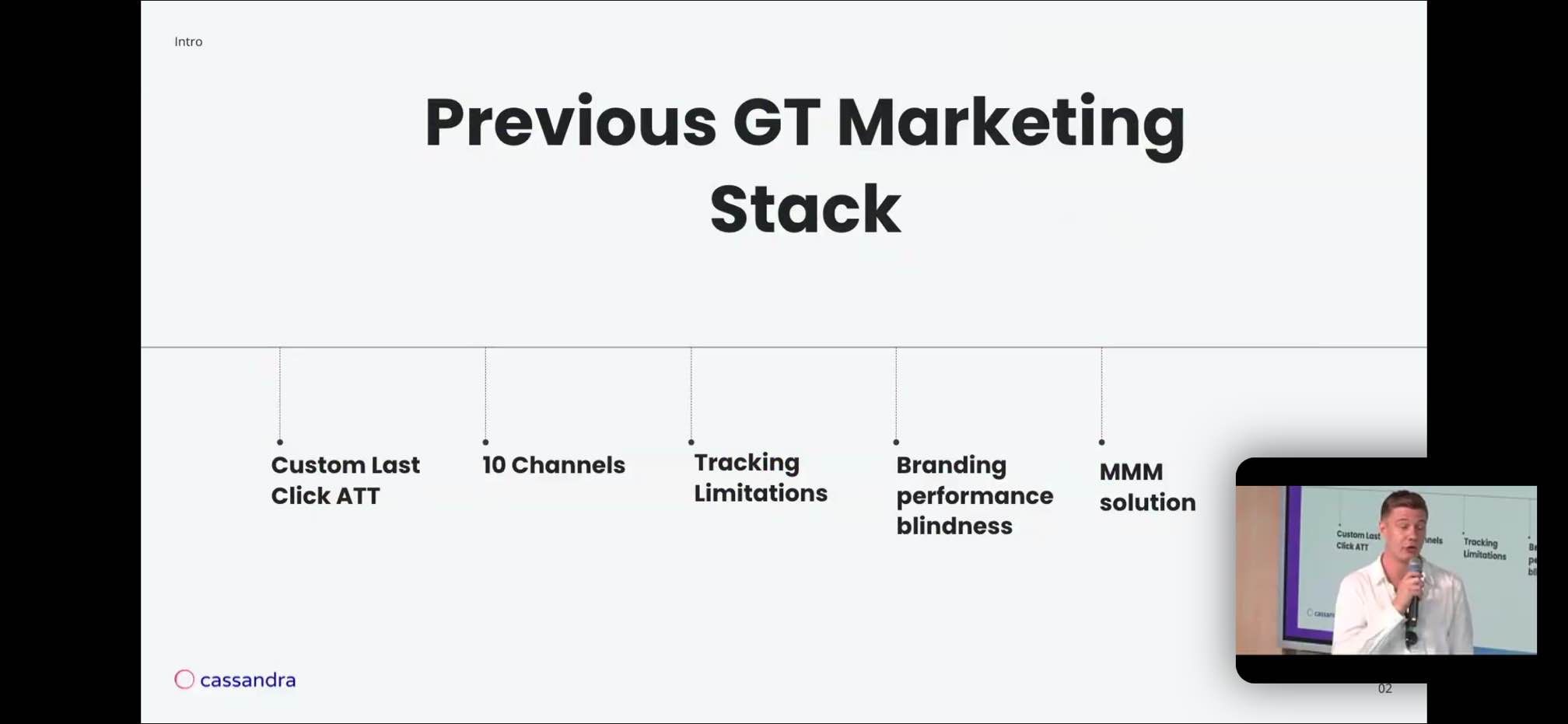
Gina Trico’s Marcus Österdahl telling about their measurement journey.
- Solution: They tried open-source options like Robyn but found them too complex, so they opted for a serviced SaaS solution with Cassandra. They first implemented Cassandra in the Netherlands and Germany, conducting a case study to validate the approach.
Results:
- Improved ROI by 53%.
- Monthly budget allocation adjustments led to smarter business decisions, considering both long-term and short-term impacts.
- Continued validation of MMM results, expanding MMM to other markets.
DNA ERA & Forvio
DNA ERA is a Slovak biotech company that provides personalized genetic insights for better health, nutrition, and sports performance, with a mission to empower individuals to lead healthier lives. They work with Forvio to enhance their marketing strategy with MMM.
Challenge: DNA ERA wanted a holistic understanding of their marketing channels' performance throughout the year, not just during peak seasons. They aimed to increase awareness of DNA tests and optimize marketing efforts.
Solution: Leveraging MMM data allowed them to make data-driven decisions, such as dynamically shifting marketing budgets to improve ROAS, simplifying access to insights, and modeling scenarios to enhance team efficiency. They also created and tested various marketing hypotheses with the budget planner.
Results:
- Increased revenue by 20% and ROAS by 25% in the first three months.
- Discovered that customers needed more time to make purchasing decisions.
- The dashboard provided easier access to insights, enabling quicker responses to results.
- Demonstrated that MMM can be effective even with smaller annual marketing budgets (under 1 million EUR).
- Accelerated decision-making processes and served as a hypothesis generator.
- Measurement not only optimized ROAS but also drove revenue increases by better understanding client behavior.
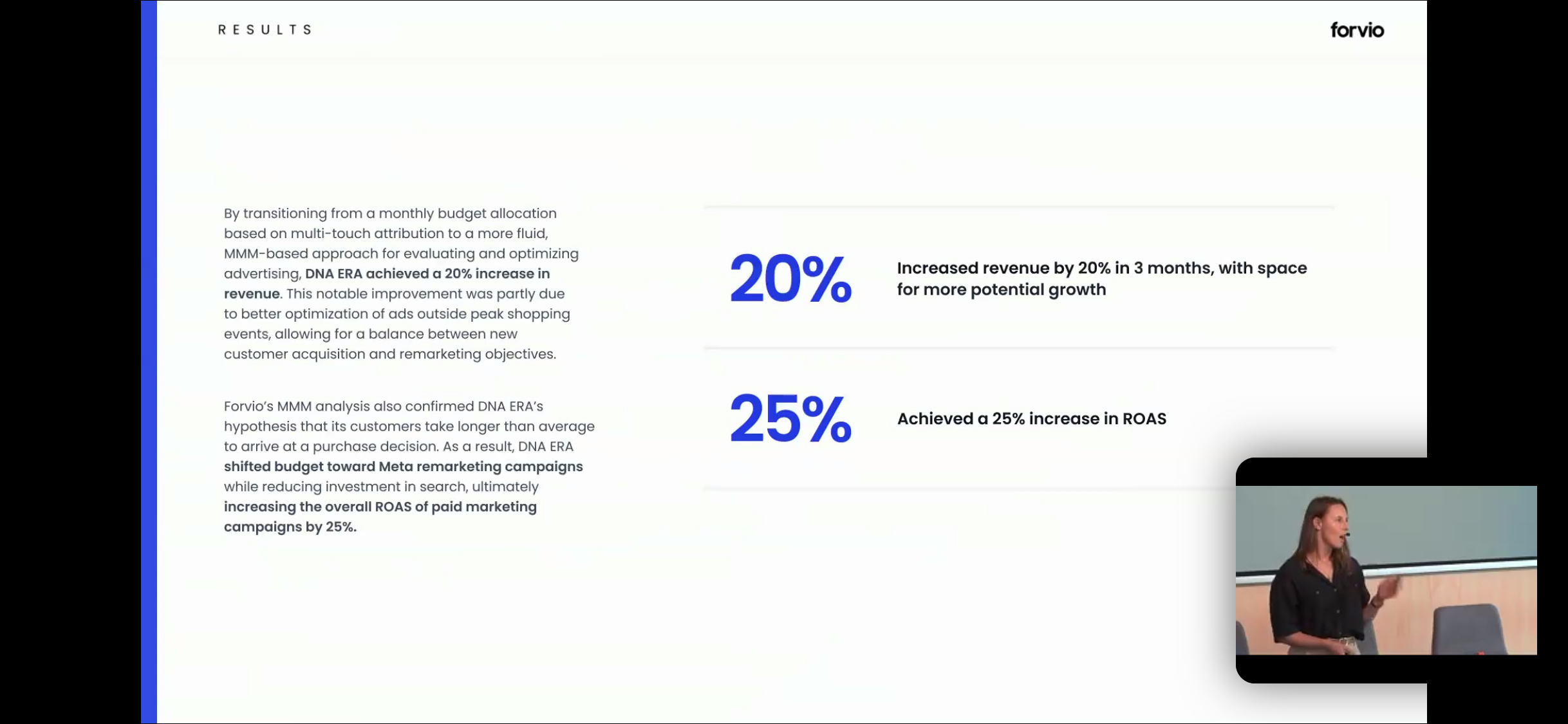
Ewa Golinska from DNA ERA discussing their results.
These success stories highlight how businesses, regardless of size, can benefit from adopting MMM to enhance their marketing strategies and achieve significant improvements in ROI and revenue.
Open Source MMM, Project Robyn, with Igor Skokan
We then listened to an enlightening talk about open-source Robyn MMM, presented by Igor Skokan, Marketing Science Director and cofounder of Project Robyn.
Why Does Meta Do Open Source?
Meta has been involved in open source for years because they believe it drives innovation. They get more in return when they share their ideas with the world, creating communities and connecting people. Today, they manage over 700 active open-source core repositories.
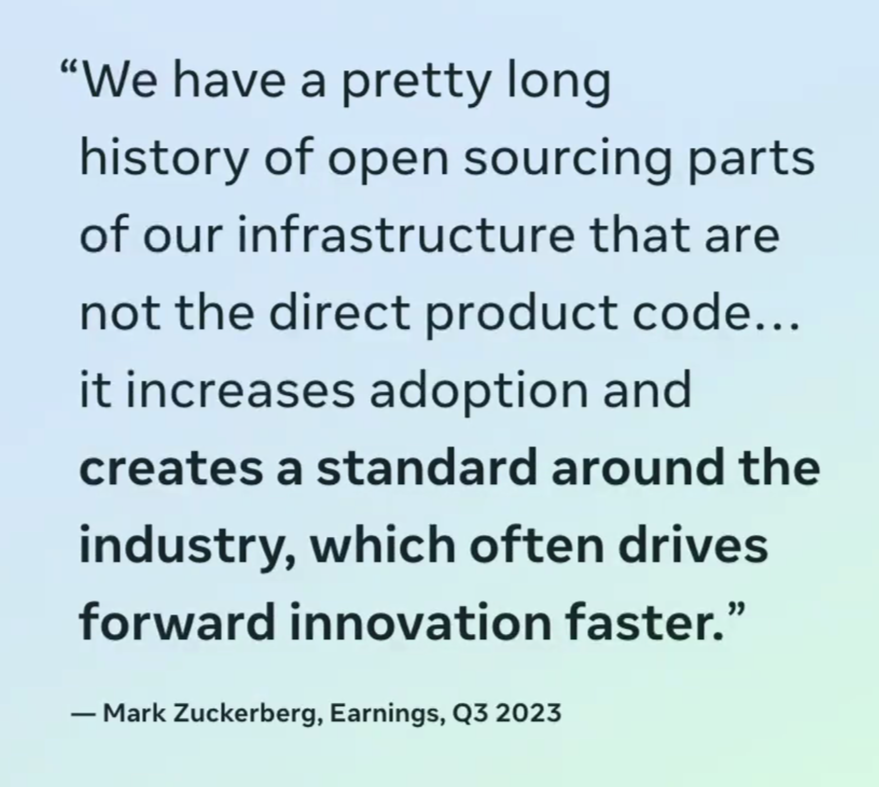
Furthermore, Meta built several open-source measurement tools to solve various challenges, such as Robyn, GeoLift, and SiMMMulator. Meta is committed to developing open source and invites anyone to be a contributor.
Great Features of Open Source Technology
- Free and Accessible: Open source technology is free and accessible to everyone.
- DIY Opportunity: It offers a great DIY opportunity for companies with in-house resources.
- Not Owned by any Platform These tools are not specific to any platform.
- Community Scrutiny: They are double-checked by thousands of developers, ensuring high scrutiny and a community that maintains the material.
Robyn as a Complementary Solution
Meta doesn't see Robyn as competing with any MMM vendors but rather as a complementary solution. Actually, Meta works with many measurement partners by giving advertisers of all sizes the tools to measure their marketing efforts.
Project Robyn
Launched almost four years ago, the goal of Robyn is to democratize superior MMM for advertisers of all sizes and build an engaging community for everyone. Robyn is an R code that you can access on GitHub; it is modular and well-documented.
Who Is It For?
Robyn is intended to complement other solutions and build a community around it. For example, third parties can take parts from Robyn and create a SaaS offer, and it is also used by research projects or companies in-house. However, it is not an official Meta product with engineering support or infrastructure and is not a service provider. Nevertheless, running the model is a small part compared to data collection, validation, calibration, etc. All of which you will have to do on your own.
Benefits of Project Robyn
- Minimizing Human Bias: Reduces human bias in the modeling process.
- Alignment with Experiments and Ground Truth: Ensures alignment with experimental data and real-world results.
- Enable Actionable Decision Making: Facilitates actionable decision-making based on reliable data.
Closing Remarks
The summit concluded with final thoughts, encapsulating the key takeaways and encouraging attendees to continue exploring and implementing MMM in their marketing strategies.
- Challenges in Understanding Cross-Channel ROI and Budget Optimization:
- The increasing privacy policies and the changing marketing landscape make it challenging to understand cross-channel ROI and optimize budgets effectively.
- The Role of MMM:
- MMM can support businesses in assessing and maximizing their return on ad spend (ROAS). It is applicable to all businesses, providing valuable insights into the effectiveness of their marketing efforts.
- Opportunities with Partners and Open Source Technologies:
- Partners and open-source technologies provide various opportunities to get started with MMM. Businesses can leverage these resources to simplify the adoption of MMM. If you prefer a guided implementation, working with partners can make the process easier. Alternatively, if you have in-house capabilities and prefer a DIY challenge, you can utilize open-source solutions like Project Robyn to implement MMM on your own.
Conclusion
The Meta Master Cross Channel Measurement Summit was a remarkable event, filled with insightful discussions and innovative ideas about MMM and marketing in general. We hope these highlights give you a glimpse into the valuable content shared during the summit. We want to thank Meta for this event and for honoring us with an invitation. Additionally, we extend our gratitude to all the participants and hosts for the engaging talks and enlightening insights.
You can watch the live recording of the Master Cross Channel Measurement with Meta Summit here.
Curious to learn more? Book a demo.

You May Also Like
These Related Stories

What is the difference? Marketing Mix Modeling vs Media Mix Modeling

Sellforte becomes an official Meta Business Partner for Measurement

